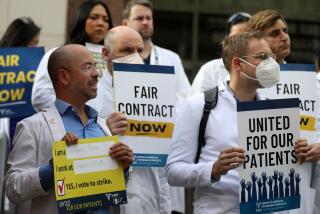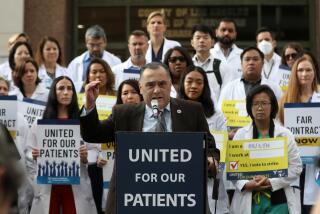Hospitals Need 25% More Nurses
- Share via
Los Angeles County’s five public hospitals are more than 25% short of the number of nurses they need to fully comply with state laws on nurse-patient ratios, and officials doubt they can substantially increase the nursing ranks anytime soon.
The data comes amid a bitter labor dispute between the county and its nurses, at least 160 of whom in recent months have refused orders from their managers to treat more patients than the law allows.
For the record:
12:00 a.m. Nov. 4, 2004 For The Record
Los Angeles Times Thursday November 04, 2004 Home Edition Main News Part A Page 2 National Desk 1 inches; 53 words Type of Material: Correction
Nurse shortage -- An article in the Oct. 26 California section said temporary nurses who work at hospitals run by Los Angeles County often are paid $70 an hour. That is the amount the county pays independent nursing services that in turn pay the nurses about $40 an hour plus benefits and expenses.
Service Employees International Union Local 660, the union representing nurses, filed complaints Monday with the state, claiming that the county doesn’t have enough nurses to safely care for patients.
County officials deny they are jeopardizing the health of patients but acknowledge they are not in full compliance with the ratios. The county says it needs 4,555 nurses to meet state rules but has only 3,361 nurses at the five hospitals.
John Wallace, a spokesman for the county Department of Health Services, said the state requirements are met “the vast majority of the time” by bringing in dozens of so-called traveling nurses who stay in the hospital for weeks to fill staffing shortages. When the county can’t get enough traveling nurses, it closes beds to patients, he added.
Some nurses say the county falls out of compliance much more regularly.
Dr. Thomas Garthwaite, director of the county’s Department of Health Services, said he is unhappy with the situation but sees little alternative. The county has struggled to hire more nurses because it pays significantly less than private hospitals and working conditions are generally considered more stressful.
“If it was unsafe today, we would take immediate action,” he said.
County-USC Medical Center and Martin Luther King Jr./Drew Medical Center have the highest number of nursing vacancies. Health Services estimated that more than 400 positions need to be filled at County-USC and more than 200 at King/Drew.
Employing temporary nurses, who are often paid $70 an hour, “is just a stop-gap measure, hopefully,” Garthwaite said. “But if you have nothing else, that keeps the place open.”
The state-mandated ratios went into effect Jan. 1. They require ratios from one nurse per patient to one nurse for every six patients, depending on the severity of the illnesses.
County nurses have been working without a contract for a year and are increasingly citing the state ratios to support their cause.
Nurses at Harbor-UCLA Medical Center and County-USC have refused to take on more patients than allowed and called union representatives to back them up. Some arguments with supervisors grew so heated that police were called.
In the last two months, the union has been distributing a leaflet explaining the state’s nurse-staffing law and pledging to defend nurses who tell their superiors the situation is unsafe.
Since then, about 20 nurses have been suspended for their defiance, and union representatives said they planned to fight those suspensions.
County officials and union representatives have met more than 50 times to reach a new agreement. At an impasse over how much to raise nurses’ salaries, the two parties will meet Nov. 4 with a state mediator.
“I think it’s harmful to not have a contract,” Garthwaite said. “And I think, from where I sit, we should be meeting nights and weekends until we get one approved.”
He said he is worried that the shortage will cause current county nurses more stress, which may cause more nurses to leave.
“At some point, you would also have a decrease in the number of patients you’re seeing, which backs up into the private sector,” he added.
State health officials visit hospitals when they have specific information about staffing shortages, and inspected a county hospital several weeks ago after they heard complaints about deficiencies.
Jacqueline Lincer, a local district manager for the state Department of Health Services, said that the report has not been completed but that inspectors told the county at the end of the visit they did not find deficiencies that day.
Los Angeles County is not alone in its struggle to meet the state’s mandate, said Jan Emerson, a spokeswoman for the California Healthcare Assn.
About 85% of the hospitals throughout the state do not meet the nurse-to-patient ratios. On average they had 15% fewer nurses than needed to fully meet the ratio rules.
At Los Angeles County’s public hospitals, the vacancy rate is 26%.
Nurses who attended a rally Monday outside of County-USC stood firm in their belief that taking on more patients risked the quality of care they could give.
Jorge Trujillo, 44, a psychiatric nurse at Harbor-UCLA, said he is regularly asked to take on nine patients when the state allows him to take only six. After refusing to see more patients Sept. 12, he received a letter suspending him, he said.
“If we are understaffed, as we are now, a patient’s first sign of agitation may not be noticed and as a result, the patient may disrupt the entire ward, agitating other patients,” he said.
Catherine Lefkowitz, a pediatric nurse at County-USC, said that she and her fellow nurses shut down a ward about three weeks ago.
All of the nurses were assigned four patients, the state maximum, and the emergency room wanted to transfer in 15 patients, she said. The nurses refused.
“They should hire more nurses,” she said.
“They’re always staffing to the bottom line, saying they didn’t anticipate emergencies or anticipate a nurse calling in sick.”
More to Read
Sign up for Essential California
The most important California stories and recommendations in your inbox every morning.
You may occasionally receive promotional content from the Los Angeles Times.










